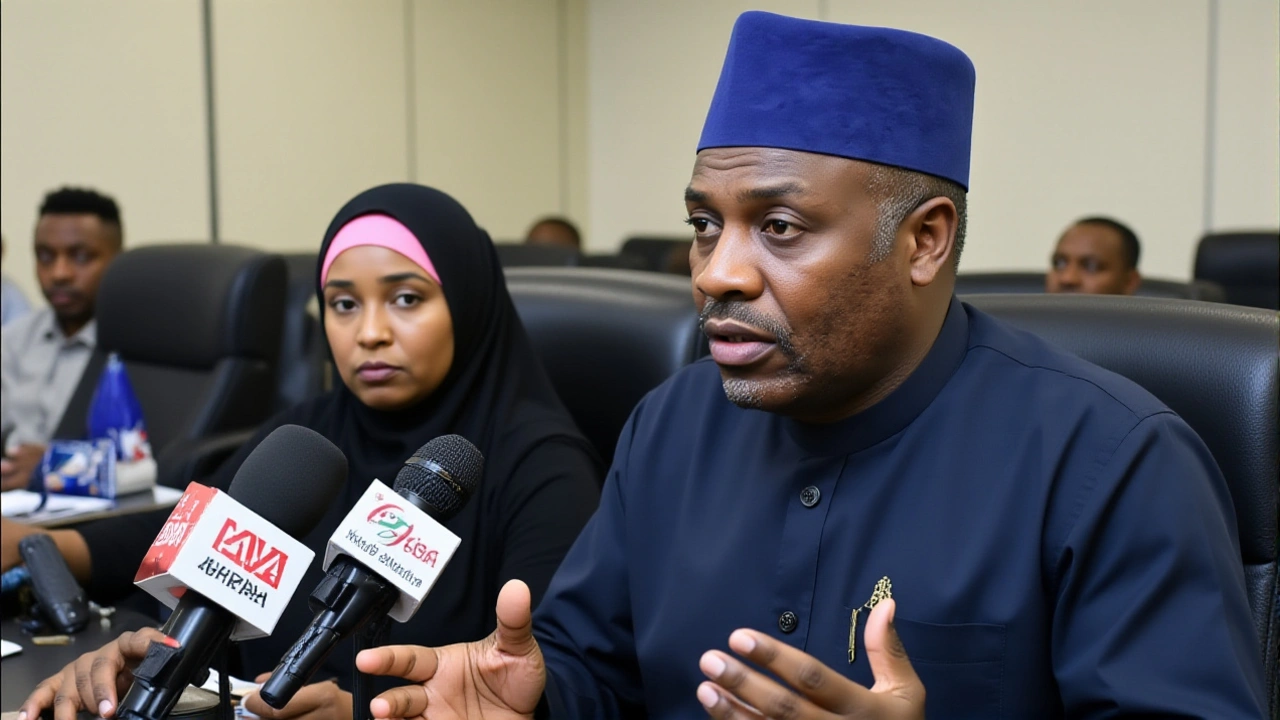ASUU Launches Two‑Week Warning Strike Across Nigeria’s Universities

When Professor Emmanuel Osuji, National President of Academic Staff Union of Universities, announced a two‑week warning strike starting at midnight on Monday, October 13, 2025, the nation’s academic calendar went into overdrive.
The strike—officially titled the ASUU Two‑Week Warning StrikeAbuja—covers all 92 federal and state universities, affecting roughly 1.5 million students and 50,000 academic staff.
Why the strike now?
Back on September 11, 2025, ASUU delegates met with a federal negotiation team in Abuja. The team was led by Dr Tunji Alausa, Minister of Education of the Federal Government of Nigeria. While officials pledged “the final phase of negotiations,” no concrete funding figures emerged, prompting ASUU to invoke its warning‑strike protocol.
Historically, the union’s bargaining chip has been the 2009 FGN‑ASUU agreement that calls for 7.5 % of the national budget to be earmarked for university funding. The October 12 statement from the Nigerian News Agency cited “unmet demands” but stopped short of naming amounts.
What the strike looks like on the ground
Starting at 12:00 am Nigerian Standard Time (UTC+1) on October 13, lecture halls from the University of Lagos in Lagos State to Ahmadu Bello University in Kaduna State will go dark. Post‑graduate supervision, research labs, and administrative services are also shelved, as per the directive released by ASUU on October 12.
- 92 universities nationwide will suspend teaching.
- ≈ 1.5 million undergraduates and post‑graduates lose classroom time.
- ≈ 50 000 lecturers, researchers, and support staff will halt work.
- The strike runs until 11:59 pm on Sunday, October 26, 2025.
Students have already voiced frustration on social media. One senior at the University of Ibadan wrote, “We’ve already lost a semester; another two weeks feels like a career‑breaker.”
Government’s response
President Bola Ahmed Tinubu (GCFR) met with his cabinet on October 10, stressing that “education remains a priority.” The Ministry of Education, meanwhile, released a statement saying it “remains committed to dialogue” and will present a revised funding proposal before the strike ends.
Dr Alausa told reporters on October 12, “We are prepared to meet the union’s core concerns, but we need data‑backed proposals that fit our fiscal reality.” No timeline was offered, leaving universities in limbo.

Impact on students and staff
Beyond the obvious loss of classroom time, the strike threatens research grants, international collaborations, and upcoming graduation ceremonies. A senior researcher at the University of Benin warned that delayed experiments could jeopardize a £2.3 million joint project with a UK university.
For many staff, the two weeks mean lost salaries and uncertainty about contract renewals. The union, however, assures members that the strike is a “protected industrial action” and that members will receive statutory strike pay where applicable.
What comes next?
If negotiations falter by October 26, ASUU has signaled it will move to an indefinite strike—a scenario that could push the 2025/2026 academic calendar into 2027. Experts from the Nigerian Economic Summit note that a prolonged shutdown would likely cost the economy upwards of ₦150 billion in lost productivity.
Analysts also point out that the timing is strategic: the strike hits just before the second semester examinations, pressuring the government to act before students’ results are jeopardized.

Background: ASUU’s history of industrial action
Founded in 1978, ASUU has a track record of using strikes to press for better funding, infrastructure, and academic freedom. In 2025 alone, the union staged three major actions: a 16‑week strike that wrapped in April, a one‑week warning strike in July, and now the two‑week warning strike.
Each bout has forced successive governments to renegotiate the budget allocation, yet the core demand for a stable 7.5 % share remains unfulfilled. The latest round echoes the 2013 standoff that saw university closures for four months.
Key facts at a glance
- Start date: 00:00 GMT+1, October 13, 2025
- End date (warning phase): October 26, 2025
- Universities affected: 92 (45 federal, 47 state)
- Students impacted: ~1.5 million
- Academic staff impacted: ~50 000
Frequently Asked Questions
How does the strike affect undergraduate exams?
Most universities have postponed semester exams originally slated for mid‑October. The delay pushes assessment timelines into December, compressing the study period for students and potentially affecting graduation dates.
What are the union’s core demands this time?
ASUU is pressing for the reinstatement of the 7.5 % budget allocation, urgent infrastructure upgrades for lecture halls and laboratories, and the fulfillment of previously promised research grants.
Will postgraduate research be halted completely?
According to the union’s directive, all academic activities—including postgraduate supervision—are suspended. Some faculty have offered voluntary remote mentorship, but it is not officially sanctioned.
What could trigger an indefinite strike after October 26?
If the federal government fails to present a revised funding proposal that meets ASUU’s baseline demands by the end of the warning period, the union has pledged to extend the action indefinitely, which would shut down teaching for the remainder of the academic year.
How are private universities affected?
Private institutions are not bound by ASUU’s strike order, but many have voluntarily halted admissions to avoid competition for limited resources and to show solidarity with public university staff.

Hemakul Pioneers
October 12, 2025 AT 22:27Seeing the nation’s universities pause their rhythm reminds me of a heart that must skip a beat to appreciate the next pulse. The strike isn’t just a political maneuver; it’s a collective sigh from scholars seeking a future where knowledge isn’t starved. When classrooms go dark, the shadows also fall on research that could translate into medical breakthroughs or technological advances. It is a moment to reflect on how funding allocations echo our values about education and societal progress. I hope the dialogue that follows will be as thoughtful as the ideas cultivated within those lecture halls.
Shivam Pandit
October 16, 2025 AT 20:54Indeed, the timing of the strike is strikingly critical, especially with examinations looming, and the government's response feels, frankly, a bit too tepid, given the stakes involved, so the union's pressure could very well catalyze the needed budget re‑evaluation, and students should brace for possible schedule reshuffles while administrations scramble to mitigate academic loss.
parvez fmp
October 20, 2025 AT 19:20Yo fam, this strike is like a massive 😤 pause button on our dreams, hope the gov steps up fast!
varun spike
October 24, 2025 AT 17:47The government's mention of a revised funding proposal suggests there may be room for adjustment, yet without transparent numbers the academic community remains in limbo and the uncertainty could affect enrollment decisions across the nation.
Naman Patidar
October 28, 2025 AT 15:14Another strike, another setback.
Vinay Bhushan
November 1, 2025 AT 13:40Listen up, fellow scholars: this is a critical juncture, and we must stand united. The administration cannot afford to ignore the glaring funding gaps any longer. Push for that 7.5% allocation with all the data at hand, and don’t settle for half‑measures. Together we can force a resolution before the semester grind becomes irreversible.
Gursharn Bhatti
November 5, 2025 AT 12:07From a philosophical standpoint, one could argue that the strike represents a manifestation of systemic neglect, a symptom of a larger malaise afflicting public institutions. Historically, when funding is withheld, the intellectual capital migrates elsewhere, eroding the nation's competitive edge. The current demand for a 7.5% budget share is not arbitrary; it reflects decades of underinvestment. If the government fails to meet this baseline, the ripple effects will extend beyond academia into healthcare, technology, and economic development. Moreover, the timing-right before exams-suggests a strategic lever to compel action. Yet, we must remain vigilant: concessions without structural reforms are merely temporary band‑aids. Transparency in the revised proposal will be key, as opaque numbers only breed suspicion. The union’s resolve, seen through repeated actions, indicates that patience has limits. In the broader picture, education funding is a litmus test for a society’s commitment to progress. Let us hope that the upcoming negotiations prioritize long‑term stability over short‑term expediency.
Arindam Roy
November 9, 2025 AT 10:34The strike will hit research timelines hard, and that’s a real worry for labs. It’s also going to delay graduate supervision for months.
Parth Kaushal
November 13, 2025 AT 09:00When the halls of learning fall silent, it feels like a whole nation inhales and holds its breath, waiting for the echo of a decision that will either set the academic world alight or plunge it deeper into darkness. The two‑week warning strike, though temporary, carries the weight of countless years of unmet promises, each day of silence a reminder of the budgetary battles fought in parliamentary corridors far from the classrooms. Students, already bruised by a lost semester, now find themselves staring at a calendar that seems to stretch endlessly, their futures hanging in the balance like a fragile manuscript waiting for ink. Lecturers, many of whom depend on these institutions not just for a paycheck but for their research ambitions, are forced to pause experiments that could have led to breakthroughs in medicine, agriculture, and technology. The ripple effect is not confined to Lagos or Kaduna; it spreads to every corner where a scholar’s curiosity once sparked innovation. Government officials, with their carefully crafted statements about “dialogue” and “commitment,” must now confront the tangible consequences of rhetoric that feels increasingly hollow. If the revised funding proposal presented by the Ministry of Education lacks the promised 7.5% allocation, the next phase could spiral into an indefinite strike, extending the academic hiatus into months, perhaps even years. That scenario would not only stall current projects but also jeopardize international collaborations that hinge on timely results, costing the nation billions in lost research grants and partnerships. Furthermore, the economic toll, estimated at ₦150 billion in lost productivity, underscores how education is intrinsically linked to the country’s overall prosperity. As private universities watch the public sector’s turmoil, many may choose to halt admissions voluntarily, further constricting higher education capacity and intensifying competition for scarce resources. In this complex tapestry of protest, policy, and aspiration, the common thread is the undeniable need for sustainable, transparent funding that honors the constitutional mandate for education. Only then can the academic community breathe freely again, turning the current warning signs into a catalyst for lasting reform.
Namrata Verma
November 17, 2025 AT 07:27Oh great, another “priority” announcement from the president-because shouting louder always solves budget shortfalls! The ministry’s ‘commitment to dialogue’ is about as convincing as a broken promise, and the timing couldn’t be more … ironic. Let’s hope the revised proposal isn’t just a re‑hash of old excuses.
Ayush Sanu
November 21, 2025 AT 05:54Statistically, a sustained 7.5% allocation correlates with higher research output, a fact the union has repeatedly substantiated. The government's delay is therefore not only politically negligent but academically detrimental.
Prince Naeem
November 25, 2025 AT 04:20In moments like these, we must contemplate the long‑term consequences for intellectual capital. The pause in teaching threatens not just current cohorts but future generations of thinkers. A balanced approach is essential.
Jay Fuentes
November 29, 2025 AT 02:47Stay positive, folks! This could be the push we need for real change. Keep the conversation going.
poornima khot
December 3, 2025 AT 01:14Dear colleagues, as we navigate this challenging period, let us remember the cultural significance of education in shaping our society. It is essential that we support one another, even as we advocate for the requisite funding. While the formal language of policy is crucial, we can also speak in the vernacular of our daily experiences, acknowledging the real‑world impact on students across the nation. May our collective voice be heard, and may we see a swift resolution that honors both tradition and progress.